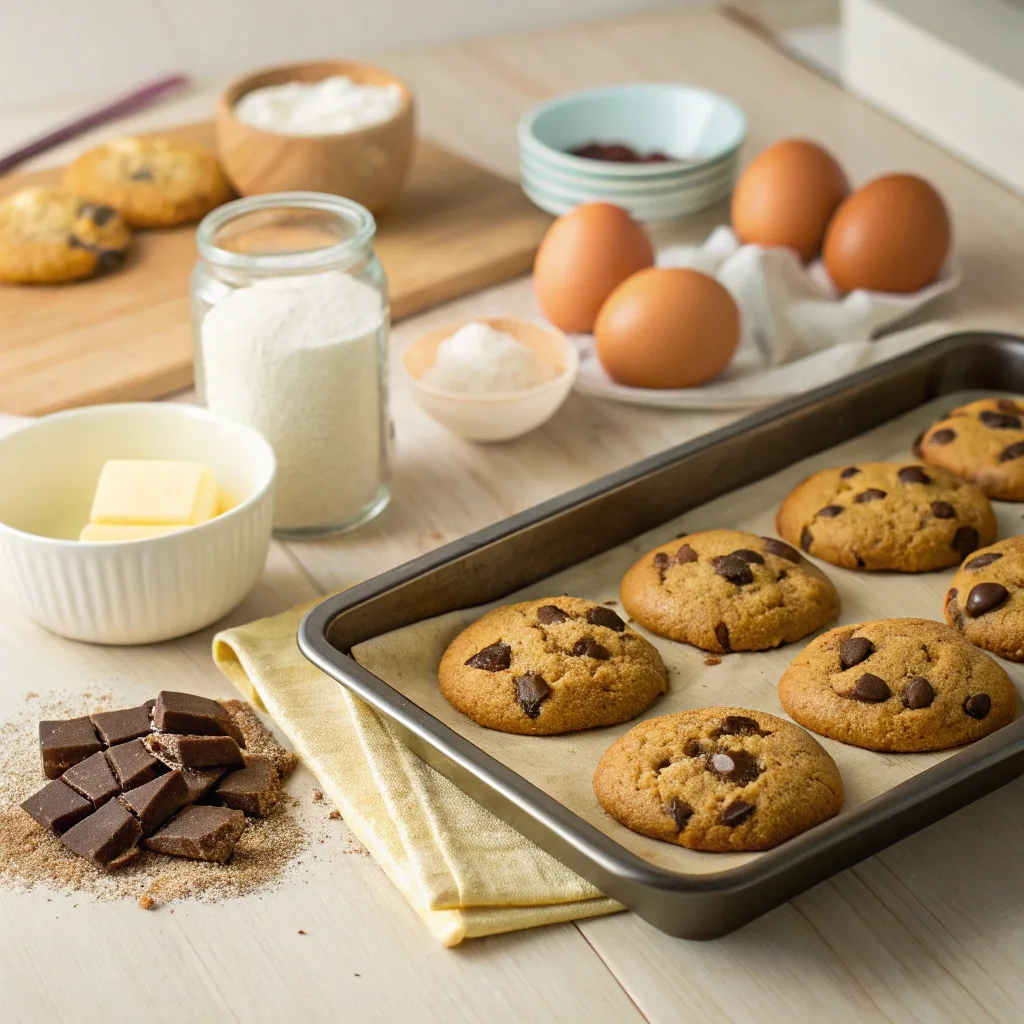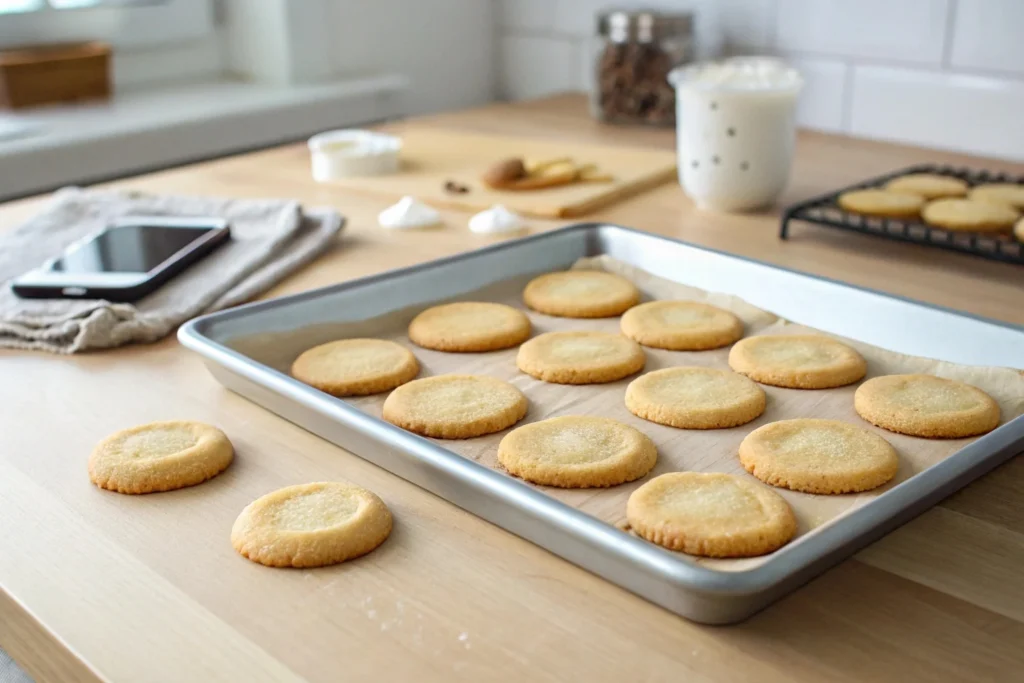Introduction
Why Do My Cookies Deflate After Baking? Understanding the Causes
Baking cookies is an art, but sometimes, despite following the recipe carefully, you might end up with deflated cookies. You may wonder, Why do my cookies deflate after baking? There are a variety of reasons this can happen, and understanding the science behind the deflation process is the key to preventing it. In this article, we will explore the common causes of cookie deflation, provide troubleshooting tips, and share expert advice to help you achieve perfect cookies every time.
The Science Behind Cookie Deflation
When baking cookies, the dough needs the right combination of ingredients and temperature to hold its shape. The primary factor that causes cookies to deflate after baking is the loss of gases that are released during the leavening process. This occurs when the leavening agents in your dough, such as baking soda or baking powder, fail to properly trap the air needed to maintain the cookie’s rise.
So, why do my cookies deflate after baking? It could be that the air was lost too quickly, or the dough was not strong enough to support the rise during baking. This can result in flat cookies that do not hold their structure once they are out of the oven.
Why Air and Moisture Matter in Baking
Air and moisture are two of the most crucial elements in baking cookies. If the right balance of moisture and air isn’t maintained, your cookies may end up deflated. The moisture content in the dough is essential because it helps the flour and other dry ingredients combine to form a dough that maintains its shape. If cookies lose too much moisture during baking, they can become dry, causing them to lose their rise and deflate.
Air plays a crucial role too. Without enough air incorporated into the dough, or if that air escapes too quickly, cookies may not rise properly. This is often why people ask, Why do my cookies deflate after baking—it is a sign that the dough wasn’t able to hold onto the air as it baked.
Common Reasons Why Cookies Deflate After Baking
There are several factors that can cause your cookies to deflate after baking. Below, we examine some of the most common reasons this happens.
Incorrect Measuring of Ingredients
Accurate measurements are essential when baking. Incorrectly measuring ingredients like flour or sugar can lead to an imbalance in the dough. For instance, if you use too much flour, the dough may become dense and dry, preventing the cookies from rising as they should. On the other hand, too little flour can lead to a runny dough that can deflate after baking.
To avoid this, it is crucial to measure ingredients correctly. For dry ingredients like flour, scoop the flour into the measuring cup and level it off with a knife to ensure accurate measurements. This small step can make a big difference in achieving the desired results.
Overmixing the Dough
One of the most common causes of cookie deflation is overmixing the dough. When dough is overmixed, it can incorporate too much air, which causes the cookies to spread too thinly during baking. Additionally, overmixing can overdevelop the gluten, leading to tough, dense cookies that may collapse after baking.
To avoid this problem, mix your dough until the ingredients are just combined. Use a gentle hand when mixing, and avoid using a stand mixer, which can be more prone to overmixing.
Baking at the Wrong Temperature
Baking cookies at the wrong temperature is another common mistake that can cause deflation. If your oven is too hot or too cold, the cookies won’t rise correctly, leading to deflation. Cookies baked at high temperatures may spread too quickly and collapse as they cool, while cookies baked at low temperatures might not rise enough.
To prevent this, use an oven thermometer to verify that your oven is at the correct temperature. Typically, cookies should be baked between 350°F and 375°F for optimal results. Always preheat your oven to the correct temperature before placing your cookies inside.
Insufficient or Old Leavening Agents
Leavening agents like baking soda and baking powder are responsible for making your cookies rise. If your leavening agents are old or ineffective, they may not release the gases needed to keep your cookies from deflating. This can result in flat, dense cookies.
To avoid this issue, check the expiration dates of your leavening agents and store them in a cool, dry place. Fresh leavening agents are essential for achieving the desired rise and texture in your cookies.
Environmental Factors: Humidity and Altitude
Environmental factors, such as humidity and altitude, can significantly affect your cookie dough and cause deflation. At higher altitudes, the lower air pressure can make the cookies rise too quickly and then collapse as they cool. Additionally, high humidity can make the dough too soft, leading to cookies that spread excessively and deflate.
If you live in a high-altitude area, you may need to adjust your recipe by reducing the amount of baking powder and adding a little more flour. If you’re baking in a humid climate, use less liquid in the dough to maintain the right consistency.
Troubleshooting Deflated Cookies
If your cookies have deflated after baking, there are several steps you can take to troubleshoot and correct the problem. Below are some tips to help you fix the issue and get the perfect cookie next time.
Measuring Ingredients Accurately
Accurate measurements are key to preventing deflation. When you ask, Why do my cookies deflate after baking, the answer often lies in the ingredient measurements. To ensure accurate measurements, always use a kitchen scale when possible. For dry ingredients, spoon the flour into the measuring cup and level it off with a flat edge.
Mixing Dough to the Right Consistency
If your dough is too soft or runny, it could cause the cookies to spread too much during baking and deflate. The dough should be soft enough to drop onto the baking sheet but firm enough to hold its shape. If it is too sticky, you can add a little more flour. The key is to mix the dough just until the ingredients are combined.
Calibrating Your Oven for Accurate Temperature
To prevent deflation caused by improper baking temperatures, use an oven thermometer to make sure your oven is calibrated correctly. Many ovens have inaccurate temperature readings, so it is crucial to double-check before placing your cookies inside. Also, ensure that you preheat your oven fully before baking.
Choosing Fresh and Effective Leavening Agents
To achieve the perfect rise, make sure you are using fresh, effective leavening agents. Check the expiration dates of your baking soda and baking powder, and store them properly. Fresh leavening agents will ensure that your cookies rise properly and avoid deflation.
Adjusting for Environmental Challenges
Environmental factors can affect your cookies, so it’s important to make adjustments for your particular location. If you live in a humid climate, reduce the amount of liquid in your dough. If you are baking at high altitudes, increase the flour slightly and adjust your baking temperature. Making these adjustments will help prevent deflation.
Pro Tips to Prevent Cookie Deflation
Here are some pro tips to help you prevent your cookies from deflating and ensure they bake to perfection every time.
The Importance of Chilling Cookie Dough
Chilling cookie dough is an effective way to prevent cookies from spreading too much and deflating after baking. When the dough is chilled, the fats in the dough solidify, which helps the cookies maintain their shape while baking. For best results, refrigerate the dough for at least 30 minutes, or even overnight.
Using the Right Baking Sheets and Trays
The type of baking sheet you use can impact how your cookies bake. Dark-colored baking sheets absorb more heat, which can cause your cookies to spread too much and deflate. For best results, use light-colored, shiny baking sheets, which promote even heat distribution and help prevent deflation.
Allowing Cookies to Cool Properly
Once your cookies are baked, allow them to cool on the baking sheet for a few minutes before transferring them to a wire rack. This allows the cookies to set properly and firm up. Moving them too soon can cause them to deflate or break apart.
Storing Cookies to Maintain Texture
Storing cookies properly is essential to maintaining their texture. Once your cookies have cooled, store them in an airtight container to prevent moisture loss and keep them from becoming hard or stale. Proper storage will help your cookies retain their texture and prevent deflation.
Real-Life Problems and How to Fix Them
Here are some real-life cookie problems you might face and how to fix them.
When Cookies Spread Too Much
If your cookies spread too much, it could be due to an excess of butter or sugar in the dough. Try reducing the amount of butter or sugar and refrigerate the dough before baking. Additionally, check your oven temperature to make sure it’s not too hot.
When Puffy Cookies Collapse While Cooling
Sometimes, cookies that are puffy when they come out of the oven may collapse as they cool. This can happen if the cookies were overbaked or lacked enough structure during baking. Try reducing the baking time and be sure the dough is the right consistency before baking.
When Cookies Turn Out Hard Instead of Soft
If your cookies are hard instead of soft, it may be due to overbaking or using too much flour. To fix this, bake your cookies for a shorter time and ensure that the dough is mixed properly before placing it on the baking sheet.
How Ingredients Affect Cookie Texture

The texture of your cookies is largely determined by the ingredients you use. Below are some key ingredients and how they affect your cookie texture.
The Role of Butter and Margarine in Preventing Deflation
Butter plays a crucial role in creating chewy, flavorful cookies. It adds richness and helps the dough spread evenly. Margarine can be used as a substitute, but it may result in cookies that spread more than desired. If you want chewier cookies, use butter for the best texture.
Balancing Sugar Ratios for Ideal Texture
The ratio of white sugar to brown sugar in your cookie dough affects its texture. Brown sugar adds moisture and chewiness, while white sugar results in crispness. Adjust the sugar ratios according to the texture you prefer.
The Impact of Eggs on Cookie Structure
Eggs help provide structure to cookie dough. The egg whites firm up the dough, while the yolks contribute moisture and richness. If your cookies are too runny, you might need to adjust the number of eggs or the consistency of the dough.
Debunking Myths: Why Your Cookies Deflate After Baking
Many myths surround the process of cookie baking. Let’s explore some common misconceptions.
Does Opening the Oven Door Ruin Cookies?
People often believe that opening the oven door ruins cookies, but this isn’t always true. However, frequent opening can cause temperature fluctuations that may affect how the cookies bake. For best results, wait until the cookies are almost done before opening the oven.
Can Overbaking Prevent Cookie Deflation?
Overbaking may prevent cookies from deflating, but it will make them hard and dry. Instead of overbaking, focus on achieving the right balance between bake time and temperature to maintain the right texture.
Expert Tips for Preventing Cookie Deflation

Achieving the perfect cookie is easier with these expert insights.
Simple Tips to Keep Cookies Puffy and Avoid Deflation
Use quality ingredients, mix your dough carefully, and always chill the dough to avoid spreading. Preheat your oven properly, and don’t overbake.
Must-Have Tools for Consistent Results
Invest in a kitchen scale, an oven thermometer, and quality baking sheets to ensure consistent, perfect cookies every time.
FAQs:
How to Stop Cookies from Spreading Too Much and Deflating
To prevent cookies from deflating, follow these key tips:
- Measure accurately: Too much flour or sugar can cause cookies to spread and deflate. Use a kitchen scale and proper measuring techniques to avoid this.
- Chill the dough: Refrigerating the dough for at least 30 minutes helps solidify the fats, which prevents the cookies from spreading too much during baking.
- Use fresh leavening agents: Expired baking soda or baking powder can affect your cookies’ rise, leading to deflation. Always check expiration dates and store leavening agents properly to ensure they are effective.
Why Do My Cookies Go Flat After Coming Out of the Oven?
If your cookies go flat after coming out of the oven, it’s likely due to one or more of the following reasons:
- Overmixing the dough: Overmixing can incorporate too much air into the dough, causing the cookies to collapse as they cool.
- Too much butter: Excess butter can cause cookies to spread too much during baking and result in deflation once they cool. Reduce the amount of butter in your recipe for thicker cookies.
- Baking at the wrong temperature: Ensure your oven is set to the correct temperature, typically between 350°F and 375°F. An oven thermometer can help confirm the temperature, preventing under or overbaking.
Why Don’t My Cookies Stay Puffy?
If your cookies don’t stay puffy, consider these potential issues:
- Too much flour or not enough moisture: If the dough is too dry, the cookies won’t have enough structure to stay puffy. Adjust the flour-to-liquid ratio to ensure the dough isn’t too stiff.
- Not enough leavening: Insufficient or old leavening agents (like baking soda or baking powder) can lead to flat cookies. Ensure they are fresh and in the correct amount to provide enough lift.
- Baking temperature: The oven needs to be at the right temperature for the dough to rise before it starts spreading. Make sure the oven is preheated and steady during baking.
How to Make Cookies Not Fall Flat?
Follow these tips to stop your cookies from falling flat:
- Chill the dough: Refrigerate the dough for at least 30 minutes before baking. This helps the fats solidify, preventing excessive spreading during baking.
- Use a thicker dough consistency: Adjust the flour-to-liquid ratio to create a firmer dough. Thicker dough helps maintain the cookie shape and reduces spreading.
- Check your leavening agents: Ensure you’re using the right amount of fresh leavening agents (baking soda or baking powder) to get the proper rise and avoid deflation.
- Use light-colored baking sheets: Dark-colored baking sheets absorb more heat, which can cause cookies to spread too much. Opt for light-colored sheets for more even baking.
By following these simple steps, you can achieve perfectly puffy and evenly baked cookies each time!
Find out why your cookies might go flat after baking and how to fix it How do I keep my cookies from going flat? while enjoying the comfort of a chunky chicken noodle soup Chunky Chicken Noodle Soup.
Conclusion
With a little practice and attention to detail, you can become a cookie-baking pro. Understanding why cookies deflate after baking and how to troubleshoot and adjust for the perfect results will help you consistently bake delicious cookies that hold their shape.
Final Thoughts on Perfecting Your Technique
Remember, practice makes perfect. By following these steps and fine-tuning your baking techniques, you’ll be able to bake cookies that are always soft, chewy, and perfectly shaped. Happy baking!




2 thoughts on “Why Do My Cookies Deflate After Baking? Causes and Tips to Keep Them Puffy”